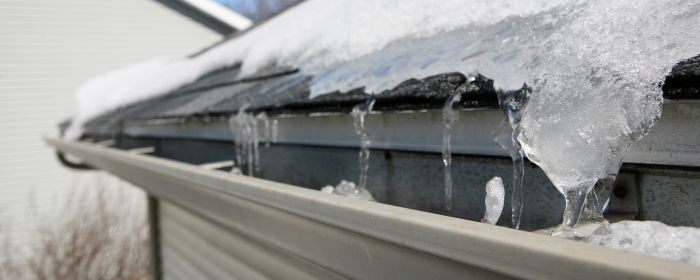Experts have predicted that this winter could be another cold and snowy repeat of last winter. Whether or not that comes true is anyone’s guess. Along with the snow will be cold temperatures and the possibility of icicles hanging from your eaves. While icicles are pretty, they are often a sign of trouble waiting to happen. The trouble isn’t the icicles themselves, but the ice dams they can create.
Is My Home at Risk for Ice Dams?
If you live in a part of the U.S. with a snowy season, your home may be at risk for ice dams. They can occur on homes throughout the northern United States, especially Minnesota and Wisconsin. Your home can be particularly susceptible to ice dams if it has a flat roof, one with a low pitch, valleys, or other features that allow water to potentially collect. Older homes are also more susceptible to ice dam damage due to the likelihood they are not as well insulated or ventilated.
What is an Ice Dam?
An ice dam is a ridge of ice that forms on a roof, usually right along the edge, but it can also occur on overhangs, flat areas and valleys. This ridge of ice acts as a dam that prevents melting snow from draining off of the roof. Over time, the ice dam grows in size and weight, which could damage your roof or even cause a collapse. More especially, any damage to the roof (as a result of the dam or otherwise) could allow water to seep inside your home and destroy walls, ceilings, floors, insulation and more.
Will Insurance Cover Ice Dams?
Insurance can help you in this situation, but that’s only after damage has occurred. Insurance is not likely to pay to remove an existing ice dam to prevent damage. Preventing a leaky roof, is the responsibility of the homeowner.
How are Ice Dams Removed?
It’s best to remove an ice dam as soon as you notice it, to prevent any further damage. If you have a single-story home, a roof rake could help sweep the snow off, Followed by an application of “snow melt”. If you have a two-story home, a flat roof, or there is a lot of built-up snow, you may need to shovel the excess snow. If you’re not up to the task, professional roof snow removers can be hired.
Can Ice Dams be Prevented?
Unlike tornados or floods caused by rising waters, this is one of the few disasters you can avoid with a little planning. Clean the gutters in the fall so melt water can flow freely. In the winter, consistently removing the snow makes it much harder for ice dams to form. A good rule of thumb is to clear the roof with a roof rake or a shovel after every 6 inches of snowfall throughout the snowy season. Good ventilation and high-quality insulation in the attic can keep the shingle temperature down, which results in slower snow melt on the roof.
Ice is more dangerous than just ice dams and water damage:
- Falling icicles can injure people.
- When falling, they can damage property as well.
- Dripping icicles can cause patches of ice that build-up on steps, sidewalks, and driveways, presenting a slip and fall risk.
Conclusion
Make sure that you have appropriate insurance in place to cover such losses caused by ice dams and melting ice. More so, be sure to take the time to prevent this hazard from ever occurring in the first place – you will be glad you did.

